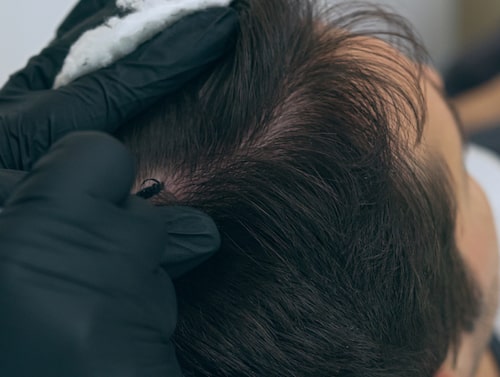The desire for a full and healthy head of hair is shared by almost everyone. Unfortunately, it is not always easy for people to gain the desired appearance to their hair. Patients who want to enjoy the appearance of a full head of hair without the need for a hair transplant often turn to scalp micropigmentation (SMP) to obtain the look of a closely shaved head of hair. In addition, SMP is able to blend-in the look of a closely shaved head of hair with the appearance of the natural hair of the patient. Interested in learning more about how SMP transforms the look of a balding scalp? Keep reading for more information!
Scalp Micropigmentation – What is It?
 In general, scalp micropigmentation is performed as a minimally invasive treatment that is able to place microscopic dots of pigment into the scalp of the patient. The placement of the pigment will fill in the areas of the scalp that are showing more skin thanks to the balding process or the appearance of thinning hair.
In general, scalp micropigmentation is performed as a minimally invasive treatment that is able to place microscopic dots of pigment into the scalp of the patient. The placement of the pigment will fill in the areas of the scalp that are showing more skin thanks to the balding process or the appearance of thinning hair.
The procedure needs to be performed with specialized medical tools in order to ensure the pigments properly match the scalp of the person. The look of hair on the scalp is created by the placement of the pigment in the papillary layer of the dermis. The natural appearance of a closely shaved head requires more than the simple placement of the pigment. The doctor needs to have an artistic eye as well as the necessary experience and training to gain the surgical skills that provide the desired look.
Specialty pigments are needed to achieve the look of a closely shaved head that is not obvious to others who view the scalp. In addition to the look of a closely shaved head, the pigment also creates the appearance of additional hair in the thinning or balding areas of the scalp when it is performed at the same time as a hair transplant in the targeted area. By matching the color of the pigment with the hair color of the patient, a natural look is obtained to the point that it is not easy for the average eye to spot the difference between the pigment and the natural hair follicles of the patient.
Scalp Micropigmentation – Ideal Candidates Revealed
Both male and female patients can be ideal candidates for SMP:
- If the person does not have enough hair to the point that they are lacking enough hair density to cover a balding area on the scalp, they can benefit from scalp micropigmentation.
- Men who are experiencing male patterned baldness and want to eliminate a visible balding horseshoe pattern on their scalp can use scalp micropigmentation to obtain the appearance of a healthier and fuller head of hair.
- A person with a visible scalp scar from an earlier surgery can reduce its visibility through SMP.
Scalp Micropigmentation – Recovery Period and Results
At the start of the SMP recovery period, a patient will experience some redness on the scalp for a period of seven to fourteen days. Plus, there will likely be an itchy or dry feeling to the scalp for that same amount of time.
Patients should not worry if the pigment has a darker look than desired immediately after the procedure as the desired color will start to appear as the recovery time continues.
While the results of SMP are not permanent in nature, they can last anywhere from three to five years. Once the pigment begins to fade over time, it will not automatically change color to the point that the changes in the look of the scalp are noticeable. A follow-up treatment will be needed to touch-up the results and help maintain the appearance of a closely shaved head. It is not necessary to have a regularly scheduled touch-up treatment, but it does help reduce the amount of fading that can happen on the scalp.
Scalp Micropigmentation – Benefits Revealed
The appearance of a fuller and healthy head of hair is not the only benefit provided by SMP. The procedure can treat hypopigmentation issues in the donor area that can occur after Follicular Unit Extraction (FUE) surgery. SMP is also an ideal treatment option for someone who is experiencing conditions with the hair, such as Alopecia Areata and Alopecia Totalis, that are not normally addressed by hair transplant surgery.
In order to obtain these benefits, the patient should schedule a consultation appointment with a doctor who is trained and experienced in performing scalp micropigmentation. The doctor can examine the scalp and also answer any questions the patient has about the process or the type of results they can expect to see after the treatment. It is also important for the patient to be medically examined by the doctor to ensure the person is healthy enough for the procedure as well as an ideal scalp micropigmentation patient.